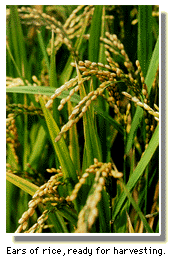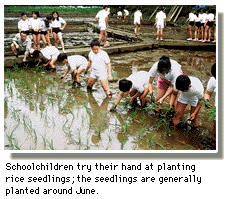 |
How was rice-growing introduced into Japan? |
 |
 People believe that the Japanese first learned to grow rice around the third century B.C. in the Yayoi period. This type of agriculture probably came to Japan from Korea and China. The type of rice found in the remains of this period is the short-grained japonica variety that's common in southern China and on the Korean Peninsula. Rice-growing seems to have come first to the northern part of the island of Kyushu in western Japan. Since Japan's mild and humid climate is good for growing this crop, it spread to the rest of Kyushu and to the other islands.
People believe that the Japanese first learned to grow rice around the third century B.C. in the Yayoi period. This type of agriculture probably came to Japan from Korea and China. The type of rice found in the remains of this period is the short-grained japonica variety that's common in southern China and on the Korean Peninsula. Rice-growing seems to have come first to the northern part of the island of Kyushu in western Japan. Since Japan's mild and humid climate is good for growing this crop, it spread to the rest of Kyushu and to the other islands. Rice became the staple, or main food, of the Japanese diet, with meat, fish, vegetables, and nuts serving as supplements. Since rice can be kept in storage, village leaders and other powerful people started building up large stores of rice, which led to a gap between rich and poor. Rice was also used to pay taxes in Japan for many centuries, until a little over a hundred years ago.
Photos courtesy of Tokyo Metropolitan Government. |
 | |
 Rice is originally a tropical plant, and it doesn't grow well when the summer is too cool. In the past the rice crop failed on many occasions in the northern part of Honshu, Japan's main island, causing great suffering for the people living there. But now varieties of rice have been developed that can stand cool summers better, and northern Honshu (the
Rice is originally a tropical plant, and it doesn't grow well when the summer is too cool. In the past the rice crop failed on many occasions in the northern part of Honshu, Japan's main island, causing great suffering for the people living there. But now varieties of rice have been developed that can stand cool summers better, and northern Honshu (the 